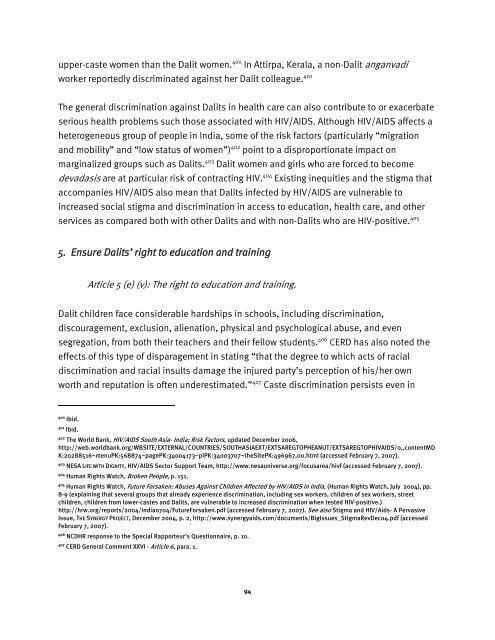Caste Discrimination against India's âUntouchablesâ - Human Rights ...
Caste Discrimination against India's âUntouchablesâ - Human Rights ...
Caste Discrimination against India's âUntouchablesâ - Human Rights ...
Create successful ePaper yourself
Turn your PDF publications into a flip-book with our unique Google optimized e-Paper software.
upper-caste women than the Dalit women. 400 In Attirpa, Kerala, a non-Dalit anganvadi<br />
worker reportedly discriminated <strong>against</strong> her Dalit colleague. 401<br />
The general discrimination <strong>against</strong> Dalits in health care can also contribute to or exacerbate<br />
serious health problems such those associated with HIV/AIDS. Although HIV/AIDS affects a<br />
heterogeneous group of people in India, some of the risk factors (particularly “migration<br />
and mobility” and “low status of women”) 402 point to a disproportionate impact on<br />
marginalized groups such as Dalits. 403 Dalit women and girls who are forced to become<br />
devadasis are at particular risk of contracting HIV. 404 Existing inequities and the stigma that<br />
accompanies HIV/AIDS also mean that Dalits infected by HIV/AIDS are vulnerable to<br />
increased social stigma and discrimination in access to education, health care, and other<br />
services as compared both with other Dalits and with non-Dalits who are HIV-positive. 405<br />
5. Ensure Dalits’ right to education and training<br />
Article 5 (e) (v): The right to education and training.<br />
Dalit children face considerable hardships in schools, including discrimination,<br />
discouragement, exclusion, alienation, physical and psychological abuse, and even<br />
segregation, from both their teachers and their fellow students. 406 CERD has also noted the<br />
effects of this type of disparagement in stating “that the degree to which acts of racial<br />
discrimination and racial insults damage the injured party’s perception of his/her own<br />
worth and reputation is often underestimated.” 407 <strong>Caste</strong> discrimination persists even in<br />
400<br />
Ibid.<br />
401<br />
Ibid.<br />
402<br />
The World Bank, HIV/AIDS South Asia- India; Risk Factors, updated December 2006,<br />
http://web.worldbank.org/WBSITE/EXTERNAL/COUNTRIES/SOUTHASIAEXT/EXTSAREGTOPHEANUT/EXTSAREGTOPHIVAIDS/0,,contentMD<br />
K:20288516~menuPK:568874~pagePK:34004173~piPK:34003707~theSitePK:496967,00.html (accessed February 7, 2007).<br />
403<br />
NESA LIFE WITH DIGNITY, HIV/AIDS Sector Support Team, http://www.nesauniverse.org/focusarea/hivf (accessed February 7, 2007).<br />
404<br />
<strong>Human</strong> <strong>Rights</strong> Watch, Broken People, p. 151.<br />
405<br />
<strong>Human</strong> <strong>Rights</strong> Watch, Future Forsaken: Abuses Against Children Affected by HIV/AIDS in India, (<strong>Human</strong> <strong>Rights</strong> Watch, July 2004), pp.<br />
8-9 (explaining that several groups that already experience discrimination, including sex workers, children of sex workers, street<br />
children, children from lower-castes and Dalits, are vulnerable to increased discrimination when tested HIV-positive.)<br />
http://hrw.org/reports/2004/india0704/FutureForsaken.pdf (accessed February 7, 2007). See also Stigma and HIV/Aids- A Pervasive<br />
Issue, THE SYNERGY PROJECT, December 2004, p. 2, http://www.synergyaids.com/documents/BigIssues_StigmaRevDec04.pdf (accessed<br />
February 7, 2007).<br />
406<br />
NCDHR response to the Special Rapporteur’s Questionnaire, p. 10.<br />
407<br />
CERD General Comment XXVI - Article 6, para. 1.<br />
94

















